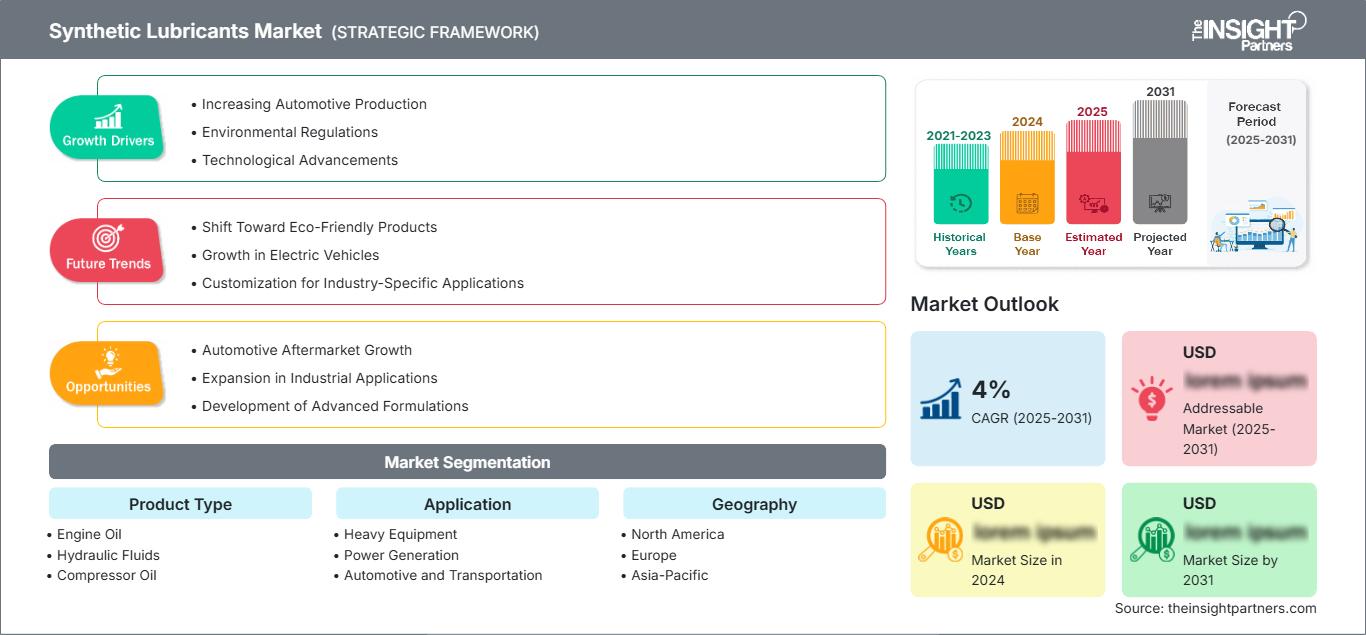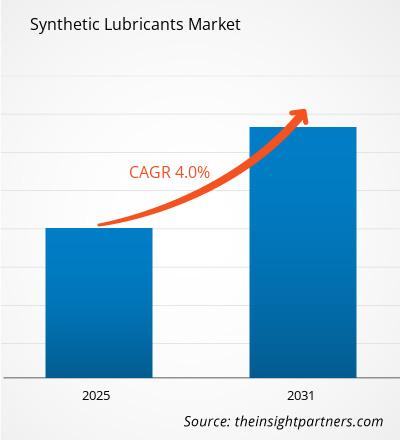Le marché des lubrifiants synthétiques devrait atteindre 48,5 milliards de dollars américains d'ici 2031. Il devrait enregistrer un TCAC de 3,5 % entre 2025 et 2031.
Le rapport est segmenté par type de produit (huile moteur, fluides hydrauliques, huile de compresseur, huile pour engrenages, fluides de transmission, huile pour turbines et autres). Il présente également une analyse par application (équipement lourd, production d'énergie, automobile et transport, métallurgie, secteur maritime et autres). L'analyse mondiale est ventilée par région et par principaux pays. La taille du marché et les prévisions aux niveaux mondial, régional et national pour tous les segments clés sont couvertes. Le rapport exprime les valeurs en dollars américains pour les analyses et segments mentionnés. Il fournit des statistiques clés sur la position des principaux acteurs du marché et présente les tendances et opportunités.
Objectif du rapport
Le rapport « Marché des lubrifiants synthétiques » de The Insight Partners vise à décrire le paysage actuel et la croissance future, les principaux facteurs de croissance, les défis et les opportunités.
Objectif du rapport
Le rapport « Marché des lubrifiants synthétiques » de The Insight Partners vise à décrire le paysage actuel et la croissance future, les principaux facteurs de croissance, les défis et les opportunités.
Cela permettra d'éclairer divers acteurs économiques, tels que :- Fournisseurs de technologies/Fabricants : Pour comprendre l'évolution de la dynamique du marché et identifier les opportunités de croissance potentielles, afin de prendre des décisions stratégiques éclairées.
- Investisseurs : Pour réaliser une analyse approfondie des tendances concernant le taux de croissance du marché, les projections financières et les opportunités tout au long de la chaîne de valeur.
- Organismes de réglementation : Pour encadrer les politiques et les activités du marché afin de minimiser les abus, préserver la confiance des investisseurs et garantir l'intégrité et la stabilité du marché.
Segmentation du marché des lubrifiants synthétiques par type de produit
- Huile moteur
- Fluides hydrauliques
- Huile pour compresseur
- Huile pour engrenages
- Fluides de transmission
- Huile pour turbines
Application
- Équipements lourds
- Production d'énergie
- Automobile et transport
- Métallurgie
- Secteur maritime
Vous bénéficierez d’une personnalisation sur n’importe quel rapport - gratuitement - y compris des parties de ce rapport, ou une analyse au niveau du pays, un pack de données Excel, ainsi que de profiter d’offres exceptionnelles et de réductions pour les start-ups et les universités
Marché des lubrifiants synthétiques: Perspectives stratégiques

-
Obtenez les principales tendances clés du marché de ce rapport.Cet échantillon GRATUIT comprendra une analyse de données, allant des tendances du marché aux estimations et prévisions.
Facteurs de croissance du marché des lubrifiants synthétiques
- Production automobile croissante : La croissance du secteur automobile, notamment avec l’essor des véhicules électriques (VE), est un moteur important pour les lubrifiants synthétiques. Ces lubrifiants offrent des performances supérieures, une consommation de carburant réduite et une durée de vie du moteur prolongée, ce qui les rend de plus en plus prisés pour les moteurs modernes, y compris les VE haute performance et les véhicules conventionnels.
- Réglementations environnementales : Des réglementations environnementales plus strictes, exigeant des émissions réduites et une consommation de carburant moindre, stimulent la demande de lubrifiants synthétiques. Ces lubrifiants améliorent le rendement du moteur et réduisent l’empreinte carbone, aidant ainsi les constructeurs à respecter les normes réglementaires et à séduire les consommateurs soucieux de l’environnement et les industries axées sur le développement durable.
- Progrès technologiques : Les progrès réalisés dans la formulation et les technologies de production des lubrifiants synthétiques ont considérablement amélioré leurs performances. Ces innovations améliorent des propriétés telles que la stabilité thermique, la résistance à l'usure et le rendement énergétique, faisant des lubrifiants synthétiques le choix privilégié pour des applications exigeantes comme l'automobile haute performance, l'aérospatiale et les machines industrielles.
Tendances futures du marché des lubrifiants synthétiques
- Évolution vers des produits écologiques : La demande de lubrifiants synthétiques écologiques et biodégradables, minimisant l'impact environnemental, est en hausse. Face à une sensibilisation croissante des consommateurs et à la pression réglementaire, les fabricants s'attachent à développer des lubrifiants moins toxiques et plus respectueux de l'environnement, répondant ainsi aux besoins des industries qui privilégient le développement durable.
- Croissance des véhicules électriques : Avec l'essor des véhicules électriques (VE), les lubrifiants synthétiques conçus spécifiquement pour leurs groupes motopropulseurs et systèmes de batteries sont très demandés. Ces lubrifiants contribuent à améliorer l'efficacité, à réduire l'usure et à assurer le bon fonctionnement des composants des VE, participant ainsi à la croissance globale du marché des lubrifiants synthétiques dans le secteur automobile.
- Personnalisation pour des applications spécifiques : La tendance aux lubrifiants synthétiques personnalisés pour des applications spécifiques est en pleine expansion. Des secteurs comme l'aérospatiale, la construction et la fabrication ont de plus en plus besoin de lubrifiants aux propriétés spécifiques pour répondre aux exigences uniques des machines hautes performances, ce qui conduit à des formulations sur mesure qui améliorent l'efficacité opérationnelle et la fiabilité.
Opportunités du marché des lubrifiants synthétiques
- Croissance du marché de l'après-vente automobile : Le marché de l'après-vente automobile en pleine expansion représente une opportunité importante pour les lubrifiants synthétiques. Face à la demande croissante des automobilistes pour des lubrifiants de meilleure qualité et plus durables pour l'entretien de leurs véhicules, les fabricants ont l'opportunité de proposer des options synthétiques avancées, offrant de meilleures performances, une consommation de carburant réduite et une protection moteur accrue afin de répondre aux besoins changeants des clients.
- Expansion dans les applications industrielles : La demande croissante de lubrifiants hautes performances dans des secteurs comme la fabrication, l'exploitation minière et l'aérospatiale offre un fort potentiel de croissance. Les lubrifiants synthétiques, reconnus pour leur capacité à résister aux températures extrêmes et à réduire l'usure des équipements, sont de plus en plus recherchés dans ces industries où la durabilité et l'efficacité sont primordiales. Développement de formulations avancées : Il existe une opportunité de développer de nouvelles formulations de lubrifiants synthétiques répondant aux besoins des industries émergentes et à l'évolution des besoins des consommateurs. Cela inclut la création de lubrifiants aux performances améliorées dans des conditions extrêmes, telles que les systèmes haute pression, les températures extrêmes ou certains types de machines, stimulant ainsi l'innovation sur le marché.
Marché des lubrifiants synthétiques
Les analystes de The Insight Partners ont analysé en détail les tendances régionales et les facteurs influençant le marché des lubrifiants synthétiques tout au long de la période prévisionnelle. Cette section aborde également les segments et la répartition géographique du marché de la gestion des troubles du rythme cardiaque en Amérique du Nord, en Europe, en Asie-Pacifique, au Moyen-Orient et en Afrique, ainsi qu'en Amérique du Sud et centrale.
Portée du rapport sur le marché des lubrifiants synthétiques
| Attribut de rapport | Détails |
|---|---|
| Taille du marché en 2024 | US$ XX Billion |
| Taille du marché par 2031 | US$ 48.5 Billion |
| TCAC mondial (2025 - 2031) | 3.5% |
| Données historiques | 2021-2023 |
| Période de prévision | 2025-2031 |
| Segments couverts |
By Type de produit
|
| Régions et pays couverts |
Amérique du Nord
|
| Leaders du marché et profils d'entreprises clés |
|
Densité des acteurs du marché des lubrifiants synthétiques : comprendre son impact sur la dynamique commerciale
Le marché des lubrifiants synthétiques connaît une croissance rapide, portée par une demande croissante des utilisateurs finaux, elle-même alimentée par l'évolution des préférences des consommateurs, les progrès technologiques et une meilleure connaissance des avantages du produit. Face à cette demande grandissante, les entreprises élargissent leur offre, innovent pour répondre aux besoins des consommateurs et tirent parti des tendances émergentes, ce qui stimule davantage la croissance du marché.

- Obtenez le Marché des lubrifiants synthétiques Aperçu des principaux acteurs clés
Points clés de la vente
- Couverture exhaustive : Ce rapport analyse en détail les produits, services, types et utilisateurs finaux du marché des lubrifiants synthétiques, offrant ainsi une vision globale.
- Analyse d'experts : Ce rapport repose sur une connaissance approfondie du secteur et des analystes.
- Informations actualisées : Grâce à sa couverture des informations et tendances les plus récentes, ce rapport garantit la pertinence de vos analyses.
- Options de personnalisation : Ce rapport peut être personnalisé pour répondre aux besoins spécifiques de vos clients et s'adapter parfaitement à vos stratégies commerciales.
Ce rapport d'étude de marché sur les lubrifiants synthétiques peut donc vous aider à décrypter et comprendre le contexte sectoriel et les perspectives de croissance. Malgré quelques points à améliorer, les avantages de ce rapport l'emportent généralement sur les inconvénients.
- Analyse historique (2 ans), année de base, prévision (7 ans) avec TCAC
- Analyse PEST et SWOT
- Taille du marché Valeur / Volume - Mondial, Régional, Pays
- Industrie et paysage concurrentiel
- Ensemble de données Excel
Rapports récents
Rapports connexes
Témoignages
Raison d'acheter
- Prise de décision éclairée
- Compréhension de la dynamique du marché
- Analyse concurrentielle
- Connaissances clients
- Prévisions de marché
- Atténuation des risques
- Planification stratégique
- Justification des investissements
- Identification des marchés émergents
- Amélioration des stratégies marketing
- Amélioration de l'efficacité opérationnelle
- Alignement sur les tendances réglementaires






















 Obtenez un échantillon gratuit pour - Marché des lubrifiants synthétiques
Obtenez un échantillon gratuit pour - Marché des lubrifiants synthétiques